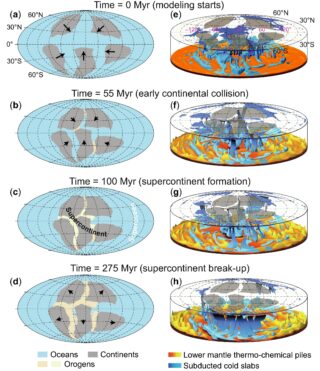Why supercontinents became shorter lived as the Earth evolved
Geodynamic modelling performed by EDRG has shown that the lifespan of the supercontinents has been decreasing due to the weakening of the orogens formed during the assembly phase. The work published in Science Bulletin suggests that this is likely caused by Earth’s secular cooling.
Periodic assembly and break-up of supercontinents since at least two billion years ago (Ga), dubbed the supercontinent cycle, provides the first-order tectonic control on the evolution of the Earth System including episodic orogenic events, mineralization, the formation and closure of oceans and superoceans, and even the evolution of life. However, the lifespan of the supercontinents appears to decrease with time, from ∼300 million years (Myr) for Nuna/Columbia, to 200–250 Myr for Rodinia and ∼150 Myr for the youngest supercontinent Pangaea.

To understand what caused such a secular decrease in supercontinental lifespan, we conducted 3-D geodynamic modeling using realistic tectonic settings. The results show that the yield stress of newly formed orogens during the assembly of a supercontinent provides the dominant control on the lifespan of the supercontinent, implying that the yield stress of young orogens becomes lower with time. We hypothesize that the decreasing mantle temperature due to Earth’s secular cooling might have caused new orogens to become weaker.

Contact person: Dr Chuan Huang & Prof Zheng-Xiang Li, Earth Dynamics Research Group, Curtin University.
Relevant publication:
Huang C., Li, Z.X., 2023. Why supercontinents became shorter lived as the Earth evolved. Science Bulletin. https://doi.org/10.1016/j.scib.2023.01.035
